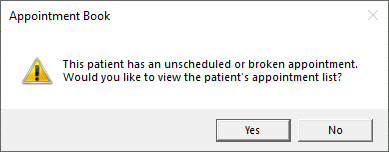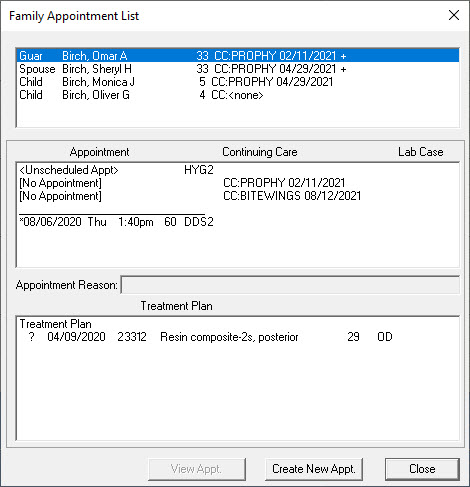Does this describe your typical reaction? You’re in the Appointment Book, and you double–click an open spot in the schedule to create a new appointment for a patient you’ve searched for and selected in the Select Patient dialog box. One of those pesky pop–ups appears and you quickly click No to get it out of your way and continuing working.
Maybe you do this because that’s how you were trained. Maybe the message doesn’t mean anything to you and you don’t dare answer Yes for fear of what might happen. Maybe you’ve seen a thousand pop–ups and they’re all the same. But wait—let’s read this one a little more closely:

If you’re not familiar with the Unscheduled List, you should be—it is one of the best tools for filling your production schedule. The message hiding in plain sight is that this patient is on your Unscheduled List, meaning they already had an appointment, but broke or canceled it. What was it for? Click Yes to find out.
Clicking Yes to the pop-up Appointment Book alert opens the patient’s Family Appointment List:

You see a comprehensive list of the patient’s scheduled and broken appointments, treatment plan information and unscheduled continuing care (not to mention the same information for everyone else in that patient’s family). Note that the items below the line and with an asterisk are past appointments.
What can you do with this information? You could ask the patient:
- Are they rescheduling their previously missed appointment?
- Would they like to be scheduled for their missed continuing care visit(s) to get back on track?
- Are they ready to begin their treatment-planned visits?
You can view the details about any of the patient’s scheduled appointments by selecting the appointment in the list and clicking the View Appt button, which opens the Appointment Information dialog box. If they are ready to schedule—or reschedule—click Pinboard and drag the appointment into an open slot in the schedule.
You can create a new appointment by clicking the Create New Appt button. That’s where you were headed in the first place; but now you are going there armed with a full knowledge of the patient’s other appointments and planned treatment, and you had a chance to convert your interaction with the patient into additional production.
A side benefit to acknowledging the pop-up and rescheduling a broken appointment is that it removes the appointment from the Unscheduled List. This will help clean up your list and keep it relevant and useful.
The next time a pesky message pops up—read it! You may find it a valuable help. For more information, check out these topics in Dentrix Help:





